Flags of different states. Flag of the CIS. Flags of the post-Soviet republics
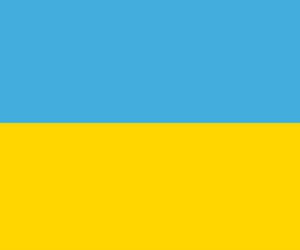
It was founded on December 8, 1991. This organization arose immediately after the collapse of the USSR. In Belovezhskaya Pushcha, the leaders of Ukraine, Russia and Belarus signed an agreement on the founding of the CIS. Later, other former republics of the USSR joined the Commonwealth, except for the Baltic states.
CIS flag: the history of official legalization
Each state and interstate association has its own symbols: flag, emblem, coat of arms, etc. CIS cannot be an exception to the rule. For some reason, the question of approving the organization’s flag did not arise immediately after signing the agreement in Belovezhskaya Pushcha. The first projects appeared in 1994. In the same year, the Council of the Interparliamentary Assembly of the CIS countries approved the draft Regulation on the flag and emblem of the organization.
The formalization of the external symbols of the international organization continued in 1995. The fact is that on May 13 this year, a meeting of the Inter-Parliamentary Assembly in its entirety was held, at which the provision on the CIS flag and its description were officially approved. It remained to go through one more formality: the documents were to be signed by the presidents of the CIS states. This event occurred on June 19, 1996.
Description of the flag of the Commonwealth of Independent States
Flags of many states or organizations arose on the basis of some historical elements. Besides, state symbols, images on them often have a certain ideological burden. If we talk about the flag of the CIS, then it was created artificially. There is no historical or particular ideological essence.
What does this symbol look like? The base is a rectangular blue canvas. Let's look at the center of the flag. There we will see a white figure. Many may have an association that they see their arms stretched upward toward the sky with some kind of appeal. But these are just vertical lines and ring-shaped strips. In the center is a circle of golden color. Observing this composition, we understand that the CIS is a peaceful organization that professes the principles of equality and partnership between states.
Ukrainian flag
We will also talk about the flags of the CIS republics. Let's start with the Ukrainian symbol. The symbol of Ukraine was officially approved by the Verkhovna Rada of Ukraine on January 28, 1992. In theory, this day should be considered the Day of the National Flag, but lawmakers have found another option. This national holiday, which does not have the status of an official day off, is celebrated on August 23, before the celebration of Ukraine's Independence Day on August 24.
![]()
What does a flag look like? This is a rectangular canvas. The top of the flag is blue, the bottom is yellow. If you divide the canvas into 5 parts, then the blue will be 2/5, and yellow - 3/5. Such coloring means "sky" and "earth". It was under this flag that military units formed on the territory of Ukraine took part in the Battle of Grunwald in 1410.
State flag of the Russian Federation
The current Russian flag is a tricolor. Historically, in appearance the Russian flag is similar to similar symbols of some European states: France, Slovenia, the Czech Republic and some others. Talking about complete identity is not worth it. With French, only colors are common. If we compare the flag of Russia with the symbol of Slovenia, we will find absolute identity, but additional images are still printed on the Slovenian canvas.
Boris Yeltsin RF December 11, 1993 approved description russian flag. This is a rectangular canvas, which consists of three identical (as stated in the text of the decree, "equal") stripes. The color of the upper strip is white, the middle is colored blue and the lower, respectively, red. In 2000, the Russian Federation adopted the constitutional law "On the State Flag".
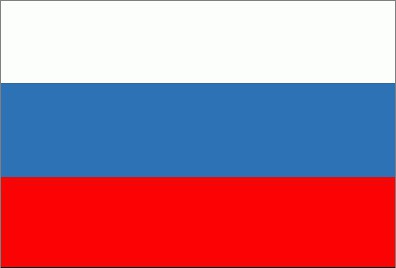
Flags of the CIS republics
A quick glance at the state symbols of the CIS countries, we will see that on most paintings there are three colors. For example, take the flag of the state of Armenia. The symbol shows three identical stripes of red, blue and orange. The canvas of the same colors was in 1919, when the nation fought for its independence. The Belarusian symbol of national sovereignty also united three colors. There are two horizontal (red and green) and one vertical stripes (red-white, with an ornament).
Flags of the CIS countries, photos of which are given in the article, are very beautiful. For example, the Moldovan flag shows the emblem of the country. We see three vertical stripes of the same size. The left is blue with a tinge of azure, the middle (where the coat of arms is painted) is yellow, and the most extreme (right) is red. By the way, it is symbolic that the red color on the flags of the CIS republics does not bring anything good. This we can say for sure (Russia, Armenia, Moldova).
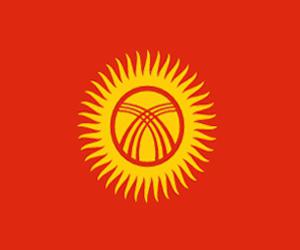
The flags of the former CIS of the Central Asian region are also original in their own way. On most of the paintings, we observe astronomical symbols: the sun, moon, stars. Of course, this makes sense, because Eastern culture and traditions have always been strong. For example, consider the general background - green. On the left we see a red-burgundy (color of power and wealth) strip, on which 5 national characters. Near this strip a crescent and five white stars are depicted.

Conclusion
The CIS flag (photo attached) is an artificially created image that does not carry any historical tradition. In principle, this is logical, because the CIS members, in addition to the period of their stay in the USSR, do not have much in common. The nationalities of the countries can be divided into several ethnic groups tightly interconnected, having common historical roots.
Pictures from the presentation “Flags of the CIS countries” to a geography lesson on the theme of "CIS" Download presentation
Flags of the CIS countries
the content of the presentation “Flags of the CIS.ppt countries”| SL | Text | SL | Text |
| 1 | Flags of the CIS countries. Compiled by: teacher of higher mathematics | 9 | National emblem Republic of Moldova. Relationship between |
| categories of public educational institution Chernyshkovskaya secondary school No. 2 Marinaenko Marina Vladimirovna | the width of the coat of arms and the length of the flag is 1: 5, the ratio between | ||
| January 2011 | the width and length of the flag is 1: 2. | ||
| 2 | Russia. The national flag of the Russian Federation is | 10 | Tajikistan. State flag of the Republic of Tajikistan |
| rectangular panel of three equal horizontal | represents a rectangular panel consisting of three | ||
| bands: top - white, middle - blue and bottom - red | horizontally located colored stripes: upper strip - | ||
| colors. The ratio of the width of the flag to its length is 2: 3. At present | red and equal to the width of the lower strip of green | ||
| time most often (unofficially) the following interpretation is used | color, middle white stripe, one and a half width dense | ||
| the colors of the flag of Russia: white means peace, purity, | stripes- On a white strip at a distance of half the length of the panel from | ||
| integrity, perfection; blue is the color of faith and fidelity, | the shaft is depicted in gold a stylized crown and a semicircle of | ||
| constancy; red color symbolizes energy, strength, blood, | seven stars above her. The ratio of the total width of the flag to the length is 1: 2. | ||
| spilled for the Fatherland. | The crown and star fit into a rectangle, the sides of which are | ||
| 3 | Azerbaijan. State flag of the Republic of Azerbaijan | verticals are 0.8, and horizontally 1.0 times the width of white | |
| consists of three horizontal stripes of equal width. Top | stripes. Five-pointed stars fit into a circle with a diameter | ||
| lane - blue, middle lane - red, lower lane - | 0.15 and are located in an arc of radius 0.5 of the width of the white strip. On | ||
| green color. Blue color means Turkic | the flag of the Republic of Tajikistan has three colors: green, red and | ||
| origin of the people of Azerbaijan, red color reflects | white. The green strip is the valleys, there are very few of them in the republic | ||
| a course towards the modernization of society and the development of democracy, and green | - 7% of the territory. The rest of the territory is occupied by mountains. White | ||
| color indicates belonging to Islamic civilization. IN | the strip is the color of the republic’s main wealth - cotton, and | ||
| the middle of the red strip on both sides of the flag is white | also the color of snow and ice in high mountains. Red is color | ||
| depicts a crescent moon with an eight-pointed star. Ratio | unity of the republic and fraternity with other peoples of the world. | ||
| the width of the flag to its length is 1: 2. | 11 | Turkmenistan. The flag of Turkmenistan is | |
| 4 | Armenia. August 24, 1990 by the Law on State | green rectangular panel with vertical | |
| the flag of the Republic of Armenia (No. С-0076-1) approved by the state | red maroon strip, which depicts five national | ||
| flag. They became the restored flag of the 1919 model: the flag, | gels, with a white crescent and five stars. Each of the gels | ||
| consisting of equal horizontal red, blue and orange | framed by carpet ornament, the outer edge of which is combined with | ||
| bands; the ratio of length to width is 2: 1. Red color | the edges of the strip. The lower part of the maroon strip depicts | ||
| the flag represented the blood shed by the Armenians in | two intersecting at the base and pointing up into different | ||
| national liberation struggle, blue - the sky of the One and | side olive branches symbolizing standing status | ||
| Independent Armenia, orange is a peaceful labor. | the neutrality of Turkmenistan. They make up with carpet | ||
| 5 | Belarus. Now the State flag of the Republic of Belarus | gels a single composition. Each olive branch consists of | |
| is a rectangular panel consisting of two | ten decreasing to the ends of leaves arranged in pairs, | ||
| horizontally located colored stripes: top - red | except lower and upper. On the larger green part in the left | ||
| colors 2/3 wide and the bottom green 1/3 wide | the top corner shows a crescent moon and five five-pointed stars | ||
| the flag. Near the pole vertically placed Belarusian | white color. | ||
| national ornament of red color on a white field making up | 12 | Uzbekistan State flag of the Republic of Uzbekistan and its | |
| 1/9 of the length of the flag, the ratio of the width of the flag to its length is 1: 2. Flag | symbolism have historical continuity with states, | ||
| mounted on a pole (flagpole), which is painted in | existing in the territory of modern Uzbekistan, given | ||
| golden (ocher) color. At ceremonies and other solemn | national and cultural traditions and climatic | ||
| state flag of the Republic of Belarus | features of the republic. The blue color on the banner is a symbol | ||
| used with diamond-shaped tip with image | eternal sky and water, as one of the main sources of life. | ||
| a five-pointed star similar to its image on | It was the blue color that was the color of the banner of the state of Amir Temur. | ||
| State emblem of the Republic of Belarus. Tips | Thus, the blue bar of the flag of the Republic of Uzbekistan is a symbol | ||
| made of yellow metal. Red color on | vitality of the republic and a sign of historical continuity. | ||
| the modern flag of Belarus symbolizes the standards of victorious | The white stripe on the flag is traditional for our population. | ||
| Battle of the Grunwald Belarusian regiments with the crusaders, color | symbol of peace, good wishes (ok yul), desire for | ||
| banners of the Red Army and the Belarusian partisan brigades, Green | moral purity of thoughts and actions. Green color - color | ||
| color - hope, spring and rebirth, forests and fields. Belorussian | nature, new life and fertility in many states where | ||
| ornament - the ancient culture of the people, spiritual wealth, | the predominant part of the population are Muslims. | ||
| unity. | It also symbolizes the close connection of history with the modern movement. | ||
| 6 | Georgia. State flag of Georgia - rectangular | green for environmental protection. Red lines - | |
| a white cloth in the center of which a large | it is a life force, inexhaustibly flowing within every living thing | ||
| a red cross, and in the four corners - the same red crosses in | the organism that connects our good, pure thoughts with the eternal | ||
| the form of the so-called "Bolnisi Cross". On the flag | heaven and real affairs on earth. The young crescent is associated with | ||
| the shade of red is #FFOOOO. Forbidden | historical traditions and at the same time can be considered | ||
| changing this shade of red on the flag. " | as a symbol of the newly born independence of the republic. Stars | ||
| 7 | Kazakhstan. State flag of the Republic of Kazakhstan | always and among all peoples were considered symbols of a cloudless sky. | |
| represents a rectangular cloth of blue color with | The national flag of the Republic of Uzbekistan shows 12 | ||
| image in its center of the sun with rays under which soaring | stars, which is directly related to historical traditions, | ||
| eagle. Images of the sun, rays and an eagle - the color of gold. On the left | ancient solar calendar starting with Navruz. Names | ||
| side of the panel is a vertical strip with a national ornament | 12 months of this calendar - hamal, sovr, javza, saraton, asad | ||
| red. The ratio of the width of the flag to its length is 1: 2 " | and others are simultaneously the names of the 12 zodiac | ||
| 8 | Kyrgyzstan The red one-color flag symbolizes | constellations. It should be noted that the symbolism of 12 stars does not have | |
| valor and courage, the golden Sun bathed in its rays, | nothing to do with religious sects and rumors. Veneration 12 | ||
| personifies peace and wealth, and the tunduk is a symbol of the home, in | stars is associated with the development of scientific thought in states | ||
| a broader understanding of the world as a universe. 40 rays | existing in the territory of present Uzbekistan. Starry | ||
| united in a circle, mean the union of 40 ancient tribes in | ulugbek catalog, scientific validity is recognized in everything | ||
| united Kyrgyzstan. Tunduk symbolizes the unity of peoples, | the world, the movement of the sun in the sky throughout the year for sure | ||
| living in the country. Flag red was flag color | determined by the location of those 12 stars of which there were | ||
| generous Manas. | mentioned above. | ||
| 9 | Moldova. State flag of the Republic of Moldova | 13 | Ukraine. "Approve State flag Of Ukraine |
| represents a rectangular cloth consisting of three | national flagrepresenting a rectangular panel, | ||
| equal colored stripes arranged vertically in the next | which consists of two equal in width horizontally | ||
| sequences from the shaft: blue (azure), yellow and | stripes: top - blue, bottom - yellow | ||
| red. In the center, on a strip of yellow, is placed | colors, with the ratio of the width of the flag to its length 2: 3 ". | ||
| “Flags of the CIS countries” | Flags of the CIS countries.ppt | |||
Http: //site/kartinki/geografija/Flagi-stran-SNG/Flagi-stran-SNG.html
Page Link
CIS
other presentations about the CIS
CIS Commonwealth - We will increase our wealth in the name of the coming years! Republic of Belarus. Uzbekistan We, the people of fraternal peoples, rallied for eternity of years! HYMN CIS The emblem of the CIS. Belarus The Republic of Uzbekistan. Kazakhstan. flag of the CIS. Descendants will not count the light paths! The Brotherhood of Slavs, Kazakhs and Armenians, And all the peoples of friendly countries!
“Russia and the CIS” - Joint organizations in the CIS. Moldova. Members of the community. Ukraine. Georgia. The goals of the organization. Samsonov, Victor Nikolaevich (1993-1997) Prudnikov, Victor Alekseevich (1997-2001). Shaposhnikov, Evgeny Ivanovich (1992-1993). Azerbaijan. The building of the Executive Committee of the CIS in Minsk. Flag of the Commonwealth of Independent States (CIS).
“Country Collaboration" - Why do I need a flag? Aliyev Ilham Heydarovich. It was established on December 8, 1991 in the Belarusian capital Minsk. Nazarbayev Nursultan Abishevich. Viktor Fedorovich Yanukovych. Blue color resembles the color of the sky, which means it symbolizes high and clear. Each nation creates and respects its own national and state symbols.
“Symbols of the CIS” - Symbols of Kyrgyzstan. Symbols of the Republic of Belarus. Map of the CIS countries. Symbols of Tajikistan. Flag. Coat of arms. Symbols of Armenia. Symbols of Uzbekistan. Symbols of Russia. Symbols of Azerbaijan. Symbols of Ukraine. Symbols of Moldova. Symbols of Turkmenistan. Symbols of Kazakhstan. "The Commonwealth of Independent States."
“Organization of the CIS” - Interparliamentary Assembly of the CIS. The initiators of the creation of the Community were Viktor Yushchenko and Mikhail Saakashvili. Lebedev Sergey Nikolaevich (since 2007). Headquarters. Cng. The Council of Heads of State meets twice a year. Chairmen of the Council of Heads of State. The CIS is not a state-owned entity and operates on a voluntary basis.
“The Commonwealth of Independent States” - Azerbaijan. Where is the CIS headquarters located? Moldova. Classroom hours: Head of the class - Fayzieva L.S. Ukraine. Name the president on a slide. The capital of which state is Baku. Purpose: to get acquainted with the countries that are part of the Commonwealth of Independent States.
Presentation on the topic: FLAGS OF CIS COUNTRIES
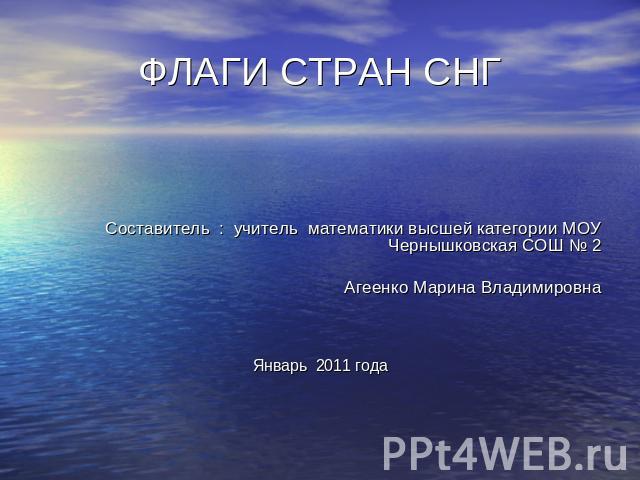

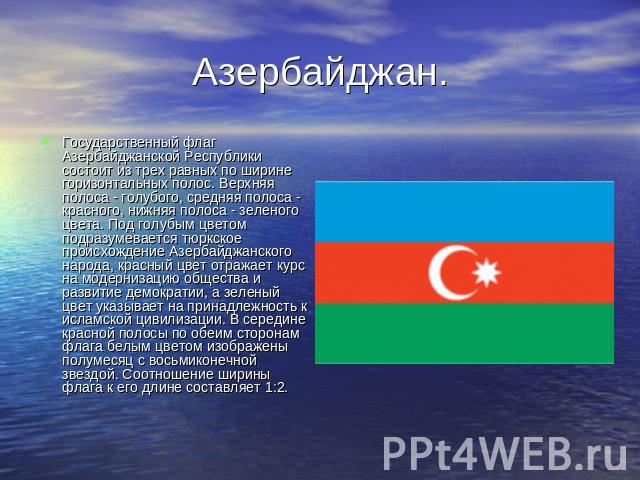
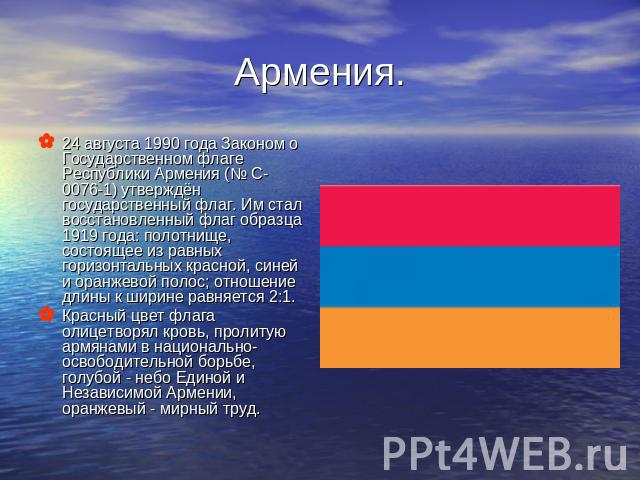



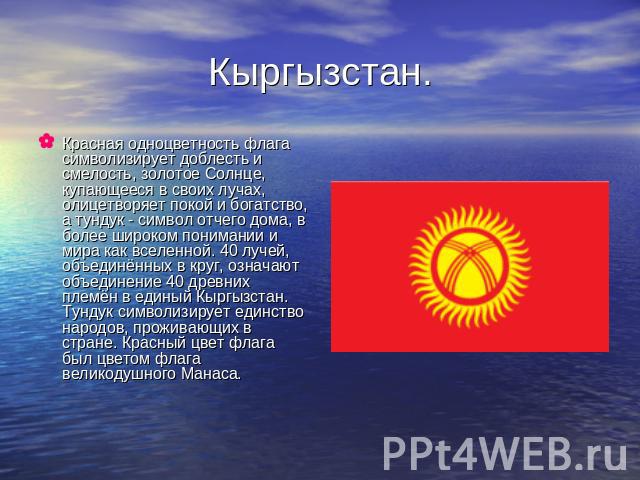
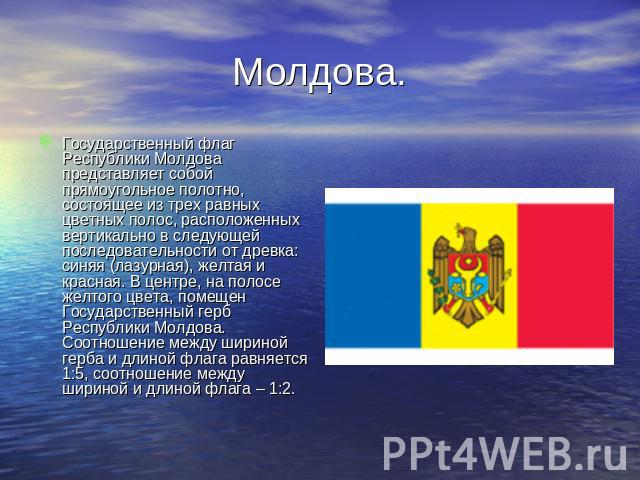

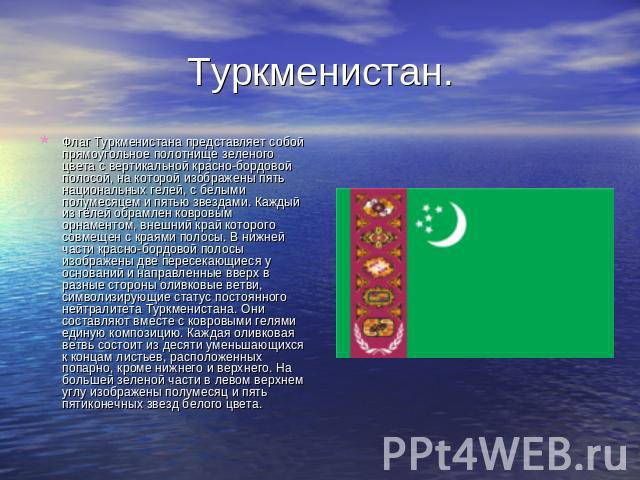
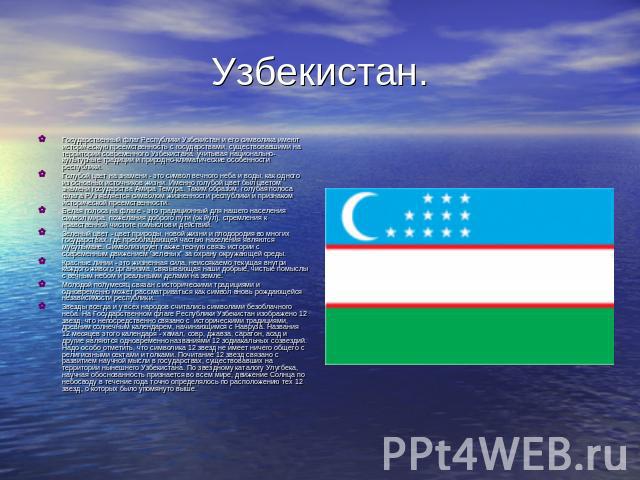
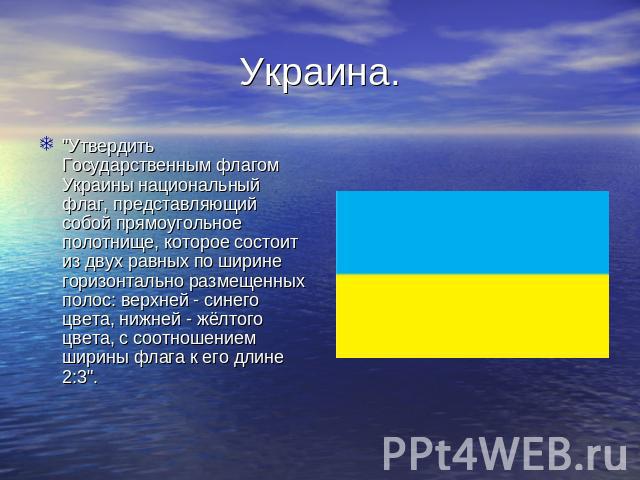
1 from 13
Presentation on the topic: FLAGS OF CIS COUNTRIES
Slide number 1
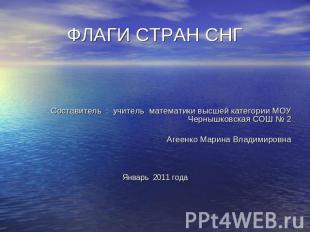
Description of the slide:
Slide number 2
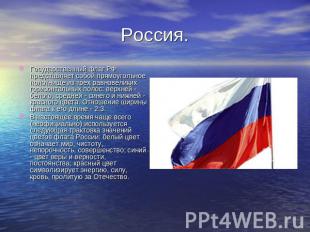
Description of the slide:
Russia. The national flag of the Russian Federation is a rectangular panel of three equal horizontal stripes: the upper - white, middle - blue and lower - red. The ratio of the width of the flag to its length is 2: 3. Currently, most often (unofficially) the following interpretation of the colors of the flag of Russia is used: white color means peace, purity, purity, perfection; blue - the color of faith and fidelity, constancy; red color symbolizes energy, strength, blood shed for the Fatherland.
Slide number 3

Description of the slide:
Azerbaijan. The national flag of the Republic of Azerbaijan consists of three horizontal stripes of equal width. The upper strip is blue, the middle strip is red, the lower strip is green. Blue color means the Turkic origin of the Azerbaijani people, red color reflects the course towards the modernization of society and the development of democracy, and green color indicates belonging to Islamic civilization. A crescent moon with an eight-pointed star is depicted in white in the middle of the red strip on both sides of the flag. The ratio of the width of the flag to its length is 1: 2.
Slide number 4

Description of the slide:
Armenia. On August 24, 1990, the State Flag was approved by the Law on the State Flag of the Republic of Armenia (No. С-0076-1). They became the restored flag of the 1919 model: a panel consisting of equal horizontal red, blue and orange stripes; the ratio of length to width is 2: 1. The red color of the flag represented the blood shed by the Armenians in the national liberation struggle, blue - the sky of United and Independent Armenia, orange - peaceful labor.
Slide number 5
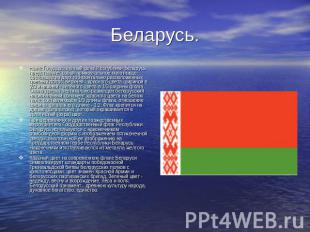
Description of the slide:
Belarus. Now the State flag of the Republic of Belarus is a rectangular panel, consisting of two horizontally arranged colored stripes: the upper one is red in width 2/3 and the lower one is green in 1/3 of the flag width. Near the flagpole, a Belarusian national ornament of red color is vertically placed on a white field, comprising 1/9 of the flag's length, the ratio of the flag's width to its length is 1: 2. The flag is mounted on a pole (flagpole), which is painted in golden (ocher) color. At ceremonies and other celebrations, the State flag of the Republic of Belarus is used with a diamond-shaped tip with a five-pointed star, similar to its image on the State Emblem of the Republic of Belarus. Tips are made of yellow metal. The red color on the modern flag of Belarus symbolizes the standards of the victorious Grunwald battle of the Belarusian regiments with the crusaders, the color of the Red Army and the Belarusian partisan brigades, the Green color - hope, spring and revival, forests and fields. Belarusian ornament - the ancient culture of the people, spiritual wealth, unity.
Slide number 6
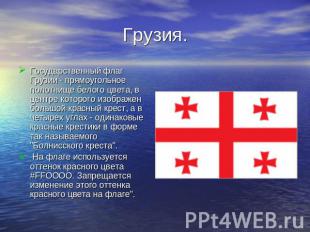
Description of the slide:
Georgia. The national flag of Georgia is a rectangular panel of white color, in the center of which a large red cross is depicted, and in the four corners there are identical red crosses in the shape of the so-called “Bolnisi Cross”. The flag uses a shade of red #FFOOOO. It is forbidden to change this shade of red on the flag. "
Slide number 7
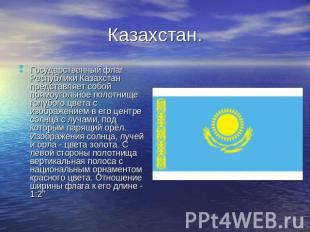
Description of the slide:
Kazakhstan. The national flag of the Republic of Kazakhstan is a rectangular cloth of blue color with the image in its center of the sun with rays under which a soaring eagle. Images of the sun, rays and an eagle - the color of gold. On the left side of the panel there is a vertical strip with a national ornament of red color. The ratio of the width of the flag to its length is 1: 2 "
Slide number 8
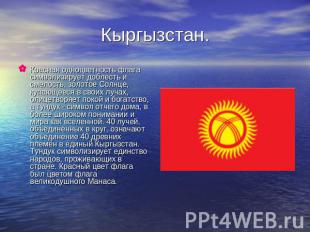
Description of the slide:
Kyrgyzstan The red one-color flag symbolizes valor and courage, the golden Sun, bathed in its rays, represents peace and wealth, and the tunduk is a symbol of the father’s house, in a broader sense, and the world as a universe. 40 rays united in a circle mean the union of 40 ancient tribes into a single Kyrgyzstan. Tunduk symbolizes the unity of the peoples living in the country. The flag red was the flag color of the generous Manas.
Slide number 9
![]()
Description of the slide:
Moldova. The national flag of the Republic of Moldova is a rectangular canvas consisting of three equal colored stripes arranged vertically in the following sequence from the shaft: blue (azure), yellow and red. In the center, on a yellow strip, is placed the State Emblem of the Republic of Moldova. The ratio between the width of the coat of arms and the length of the flag is 1: 5, the ratio between the width and length of the flag is 1: 2.
Slide number 10
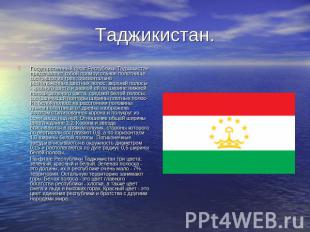
Description of the slide:
Tajikistan. The national flag of the Republic of Tajikistan is a rectangular panel consisting of three horizontally arranged colored stripes: the upper strip is red and equal to the width of the lower strip of green, the middle white strip is one and a half widths of dense stripes- On a white strip at a distance of half the length of the strip from the shaft there is a stylized crown and a semicircle of seven stars above it. The ratio of the total width of the flag to the length is 1: 2. The crown and star fit into a rectangle, the sides of which are vertically 0.8, and horizontally 1.0 times the width of the white strip. Five-pointed stars fit into a circle with a diameter of 0.15 and are located in an arc of radius 0.5 of the width of the white strip. There are three colors on the flag of the Republic of Tajikistan: green, red and white. The green strip is the valleys, there are very few of them in the republic - 7% of the territory. The rest of the territory is occupied by mountains. The white strip is the color of the republic’s main wealth - cotton, as well as the color of snow and ice in the high mountains. Red is the color of the unity of the republic and fraternity with other peoples of the world.
Slide number 11
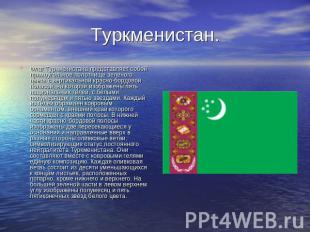
Description of the slide:
Turkmenistan. The flag of Turkmenistan is a rectangular green cloth with a vertical red-burgundy strip, which depicts five national gels, with a white crescent and five stars. Each of the gels is framed by a carpet ornament, the outer edge of which is aligned with the edges of the strip. In the lower part of the red-burgundy strip are two olive branches intersecting at the bases and pointing upwards in different directions, symbolizing the status of permanent neutrality of Turkmenistan. Together with carpet gels they form a single composition. Each olive branch consists of ten leaves decreasing towards the ends, arranged in pairs, except for the lower and upper. The crescent and five five-pointed white stars are depicted on the larger green part in the upper left corner.
Slide number 12
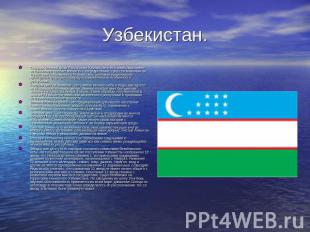
Description of the slide:
Uzbekistan The national flag of the Republic of Uzbekistan and its symbols have historical continuity with the states that existed on the territory of modern Uzbekistan, taking into account the national cultural traditions and climatic features of the republic. The blue color on the banner is a symbol of the eternal sky and water, as one of the main sources of life. It was the blue color that was the color of the banner of the state of Amir Temur. Thus, the blue strip of the flag of the Republic of Uzbekistan is a symbol of the vitality of the republic and a sign of historical continuity. The white strip on the flag is a traditional symbol of peace for our population, wishes for a good journey (ok yul), striving for the moral purity of thoughts and actions. Green color is the color of nature , new life and fertility in many states where Muslims are the predominant part of the population. It also symbolizes the close connection of history with the modern green movement for the protection of the environment. The red lines are the life force inexhaustibly flowing within every living organism, connecting our good, pure thoughts with the eternal sky and real deeds on earth. The young crescent moon is connected with historical traditions and at the same time can be considered as a symbol of the republic's newly born independence. Stars and always among all peoples were considered symbols of a cloudless sky. The national flag of the Republic of Uzbekistan shows 12 stars, which is directly related to historical traditions, the ancient solar calendar, starting with Navruz. The names of the 12 months of this calendar - hamal, sovr, javza, saraton, asad and others are simultaneously the names of 12 zodiac constellations. It should be especially noted that the symbolism of 12 stars has nothing to do with religious sects and senses. The veneration of 12 stars is associated with the development of scientific thought in the states that existed on the territory of present-day Uzbekistan. According to the star catalog of Ulugbek, scientific validity is recognized all over the world, the movement of the Sun in the sky during the year was precisely determined by the location of those 12 stars, which were mentioned above.
Slide number 13
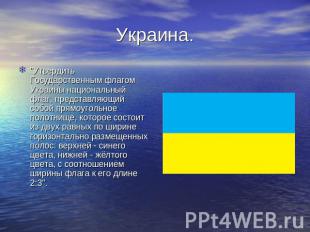
Description of the slide:
Ukraine. “To approve with the State flag of Ukraine the national flag, which is a rectangular panel, which consists of two horizontally spaced stripes of equal width: the upper one is blue, the lower one is yellow, with the ratio of the flag's width to its length 2: 3.”
- The training system according to the Dalton plan - the organization of the educational process - Sergei V. Sidorov
- Internal differences, specialization of individual cities
- Consonant and letter th
- Not a single word: whom to work after philology
- Warning flags on the beach
- Abstract of speech therapy classes in elementary school
- Sound and Alpha Word Analysis

 Live journal
Live journal Facebook
Facebook Twitter
Twitter